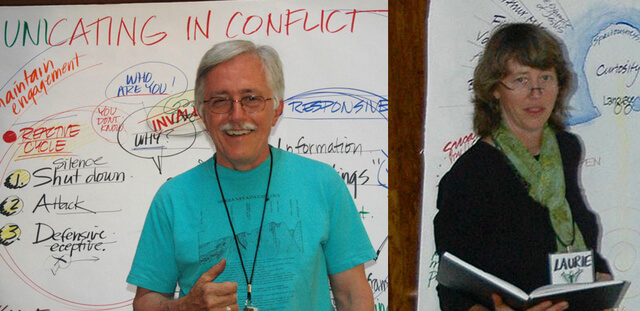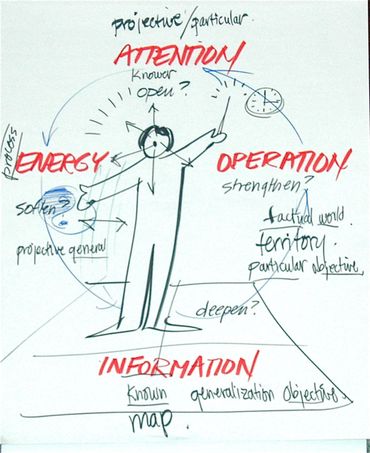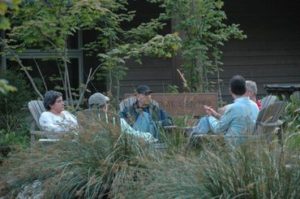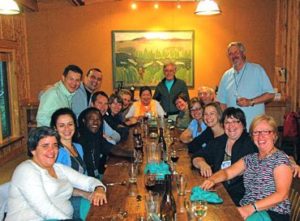Facilitation Mastery: Experiencing the Four Flows
 “I didn’t realize that we would be doing so much personal development,” one participant said in our closing circle at the Facilitation Mastery Workshop, held recently at Islandwood Conference Center on Bainbridge Island in Washington. “The way you and Laurie showed up made it possible,” someone said. “This was transformational for me,” another said.
“I didn’t realize that we would be doing so much personal development,” one participant said in our closing circle at the Facilitation Mastery Workshop, held recently at Islandwood Conference Center on Bainbridge Island in Washington. “The way you and Laurie showed up made it possible,” someone said. “This was transformational for me,” another said.
I’m still deeply moved by the experience, and so is the group. We are all communicating still through a Base Camp website that Grove Senior Associate Tom Benthin (who attended the workshop) set up for everyone. Poems and reflections are flying!
This was the sixth time that I’ve opened to spending a week with a group of people who have attended other Grove workshops but want to work more deeply. It’s come to be a benchmark for me and my own development. In fact, that is a good part of why we conduct the workshop. I do it with Laurie Durnell, the head of The Grove’s consulting group, and our own dance of preparation, delivery, and learning afterward is part of our development.
Why Focus on Personal Development?
 I want to reflect a little on why I think that personal development is essential to masterful facilitation, and how we approached teaching about “mastery.” The Grove defines facilitation as “the art of leading group process toward agreed on outcomes with full participation, creativity, and ownership from all involved.” Facilitation is all about serving the group and its collective purpose as distinguished from one’s own. Leaders and team managers are ones who often set the purpose and goals for a group. Consultants may often be agents for leaders, but when a person says they are facilitating, most people would expect them to serve the group.
I want to reflect a little on why I think that personal development is essential to masterful facilitation, and how we approached teaching about “mastery.” The Grove defines facilitation as “the art of leading group process toward agreed on outcomes with full participation, creativity, and ownership from all involved.” Facilitation is all about serving the group and its collective purpose as distinguished from one’s own. Leaders and team managers are ones who often set the purpose and goals for a group. Consultants may often be agents for leaders, but when a person says they are facilitating, most people would expect them to serve the group.
This intention plunges anyone who takes up facilitation into the position of needing to take everyone into account during a process. Given that orientation, one measure of mastery would be the extent to which a facilitator can relate to, understand, and help a wide range of people. That capability requires one come to accept, with humility, all the different aspects of oneself and aspects of other people that you might not be comfortable with personally.
It is possible to facilitate within an industry or a given functional area and develop a lot of proficiency without spreading out to the full spectrum of positions, thinking and learning styles, and areas of expertise represented in sizable organizations. It is also possible to be very facilitative without a lot of experience if one is firmly anchored in beginners mind and being able to learn VERY quickly from the group.
If you are graphically facilitating, however, and choosing to visually reflect the group’s process and thinking on large charts as a way of guiding the group, your listening and sensibility is completely exposed! This raises the bar on what constitutes mastery.
Facilitation becomes even more challenging if one works across sectors and boundaries, works with entire organization systems, or moves into community involvement and transformation processes. This work calls for deeper than ordinary command of ones own awareness and sensibility. Developing this depth and introducing practices for ongoing development is what the Facilitation Mastery workshop seeks to provide.
I personally can’t conceive of someone being a good facilitator without working hard on his or her own personal development. In my own experience, I find myself limited much more by my own awareness than by limitations in the situations in which I facilitate. And so I work out.
The Mastery Workshop is one of our workout practices. To insure that we have to model actual best practice as well as talk about it, we design the workshop so that the learning’s are embedded in the structure and experience as well as our demonstrations and presentations. In fact, the participants design the last two days, forcing Laurie and I to show up as true facilitators all the way through the process of turning over control to the group!
Grove Facilitation Model and the Four Flows
The design of the workshop is built around The Grove’s Facilitation Model, itself built on a framework called “The Four Flows,” inspired by Arthur M. Young’s Process Theory. Following is an illustration of the model, linked to the key questions in the Drexler/Sibbet Team Performance Model (also inspired by Process Theory). It illustrates what a facilitator needs to attend to while the group is focusing on things like purpose, trust, goals, commitments and the like.
 The four levels provide an archetypal way of thinking about the four ways we humans relate to things. Since we are creatures that live upright on the Earth, and ground is down, we illustrate the most constrained level, the “Operational” level of group process as on “the ground.” The least constrained and freest way we relate is through our consciousness and attention. This is illustrated as the top level. In between is our experience of “energy”—meaning the movement, dynamics, and emotional body of a group— and “information,” referring to human’s ability to think symbolically in words, pictures and numbers. In ancient times these levels might have been called “spirit,” “soul,” “mind,” and “body.” These “flow” also resonate with what Carl Jung called intuition, feeling, thinking, and sensing.
The four levels provide an archetypal way of thinking about the four ways we humans relate to things. Since we are creatures that live upright on the Earth, and ground is down, we illustrate the most constrained level, the “Operational” level of group process as on “the ground.” The least constrained and freest way we relate is through our consciousness and attention. This is illustrated as the top level. In between is our experience of “energy”—meaning the movement, dynamics, and emotional body of a group— and “information,” referring to human’s ability to think symbolically in words, pictures and numbers. In ancient times these levels might have been called “spirit,” “soul,” “mind,” and “body.” These “flow” also resonate with what Carl Jung called intuition, feeling, thinking, and sensing.
This kind of conceptual model is a type of map aimed at visualizing the complete span of considerations needed, stated at a general level of abstraction. However it is not the “territory” itself—the actual situation of any specific group, where all these things happen together. This why we believe the workshop can’t just be about ideas; it must actually create the realities we deal with experientially.
Becoming Aware of Metaphor
In calling this model a “map” I’m using a metaphor to help with understanding. Using metaphor consciously is another skill involved in mastering facilitation. Humans make sense out of things by comparing what they know with what they don’t know. If the comparison says one thing “is” another thing it qualifies as a metaphor. If I say it is “like” another thing it qualities as an analogy.
For instance, I could have said, and did in the workshop, that the Facilitation Model is like a mental keyboard for composing meaning along the “staff” lines of the four flows. This is an analogy. With this comparison one might infer that the real process of a group is as complex as a real piece of music, and not be confused with the keyboard. That makes the design and elegance of the “keyboard instrument” even more critical, and hopefully encourages improvisation and “playing around.”
Much of the complexity of working with groups graphically and especially working with groups as a graphic facilitator where one is writing and drawing down what people say, is learning to understand analogy and metaphor and fly easily through them without getting stuck and confused. (Notice the “fly” metaphor?)
Just to make sure everyone wasn’t stuck in any specific representation of these ideas (i.e. the specific way the Four Flows is drawn as channels), I also shared it as a set of concerns that surround the body of a facilitator, as such, illustrating the facilitator as a conductor. While this is still a musical analogy it is a different representation that chases out different understanding.
 On this chart attention is mapped onto the head, energy into the left hand, operations as the right (control) hand, and information being the platform one stands on as a graphic facilitator. This way of looking at it, if one appreciates it as an example of a classic “four-fold operator” in Process Theory, shows the substantial aspects we experience (our emotional life and our physical life) as the two opposing hands on a horizontal axis. Young insisted these two modalities cannot be appreciated consciously at the same time; that we choose to either tune into our feelings on the left hand or to make decisions and control and interact precisely with mechanisms on the right.
On this chart attention is mapped onto the head, energy into the left hand, operations as the right (control) hand, and information being the platform one stands on as a graphic facilitator. This way of looking at it, if one appreciates it as an example of a classic “four-fold operator” in Process Theory, shows the substantial aspects we experience (our emotional life and our physical life) as the two opposing hands on a horizontal axis. Young insisted these two modalities cannot be appreciated consciously at the same time; that we choose to either tune into our feelings on the left hand or to make decisions and control and interact precisely with mechanisms on the right.
These “real life” aspects are complemented by two imaginary aspects, which are illustrated on a vertical axis. Our attention (the freest way we relate) is illustrated around our heads, and our objective thinking (which is constrained by the generalizations of language) is illustrated as the platform we stand on. Neither of these is substantial in the same way feelings and physical form is (i.e. they don’t have weight, force, or physical form).
Now I realize that in this short blog post I can’t fully defend this way of seeing things or even explain it fully. I want to simply give a flavor of the kinds of nuances that a skilled facilitator entertains when thinking about thinking. Working with multiple mental models is a core skill in more masterful levels of practice.
Experiencing the Four Flows
As I explained, the workshop was designed so that participants would experientially immerse in each of the Four Flows with enough intensity that we could distinguish the differences and then play with the combinations.
During the orientation on day one we worked with attention, concentrating on how we “framed” the workshop and what inner intentions and purposes we each brought to the work. Then we identified our “growth edges”—those areas we are aware of and interested in but haven’t yet embodied.
The second day was spent on “energy” and our emotional intelligence, or our “soul body” if you prefer.
The third day was focused on thinking about facilitation and Process Theory, getting behind and under the models and methods. We ended the third day with a session in which we had two volunteers facilitate the group designing the rest of the workshop, using modules we suggested as well as some of their own.
Days four and five were spent implementing these decisions and covering a wide variety of graphic facilitation concerns.
Working the Flow of Attention
Since attention is fundamental, we threaded reflective process throughout. If you think of attention as a flashlight (metaphor again), then it can be broad or narrow beam. It can also be turned inward or outward. A facilitator needs to not only be aware of his or her own awareness but also imagine what people in the group are attending to. So how does a person develop mastery in being aware of attention?
Our big exercise day one was having people create large personal portraits of themselves inside an outline of their bodies drawn by a partner. These portraits were “current state” pictures looking at four aspects of ourselves (these questions were derived from thinking about the four flows). The question we asked of ourselves are the following:
1. What inspires you?
2. What nurtures you?
3. What intrigues you?
4. What are you committed to?
5. What gifts are you bringing to this workshop?
 This image was my graphic answer. Answers to question #1 are along the top. Question #2 answers are along the left side. Question #3 answers are along the bottom. Questions #4 answers are on the rights side. And Question #5 answers are inside my body outline.
This image was my graphic answer. Answers to question #1 are along the top. Question #2 answers are along the left side. Question #3 answers are along the bottom. Questions #4 answers are on the rights side. And Question #5 answers are inside my body outline.
Identifying Growth Edges
Ringed around the room, these portraits felt like being surrounded by mythic Olympians! We used them to identify our “growth edges.” Laurie and I encouraged everyone to listen to other people’s introductions of their self-portraits and notice what they felt drawn to, and what they felt a bit bothered by.
The idea of “growth edges” compares humans to living trees, and assumes that each year I add rings of new growth. As I get older more and more of myself is established, but notice that even older trees have a percentage of their growth that is on the edge, moving out into new territory.
In psychological terms, my edge is those things I am just becoming aware of but haven’t yet embodied. I believe I can discover my edge by looking at what attracts me in other people that isn’t present yet in my own life. I can also look at what repels me. Both represent awareness at our edges. One can only be attracted or repelled by something one is ready to understand. Otherwise we wouldn’t even notice. I’ve learned that when I begin to pay a lot of attention to something, then it begins to gather energy. Then I learn more about it, and eventually it actually manifests in my physical world and life.
My edge was “working without using talking; working with the subtle energies.” As I enter into my elder years I am more and more seeing my service as being a “holder of the container” rather than the contents for a group. Listening with full attention without talking creates a container of listening around another person. And the active ingredient, I’ve come to experience, is the extent to which I am sincerely, and actually fully engaged in opening to the other person’s communication inside my own consciousness.
I believe that ultimately the methodologies of meditation, yoga, journaling, dreamwork, and the like are pretty essential to making much progress in mastering attention and awareness. The Grove doesn’t espouse any particular path, but Laurie and I both encouraged people to find one that works for them.
Soul Collage
We focused on the flow of energy on day two through story telling, outdoor experiential exercises (blind squares for those of you who are ropes course users) and soul collage. This latter activity proved to be one of the most powerful parts of the workshop. It’s a practice Laurie uses extensively, and requires only a focal question, and the willingness to let one’s intuition pick and combine magazine images that reflect responses to the question. Laurie regularly cuts out evocative images from magazines and had several large stacks of them.
The question we posed was “what would you be like if you fully embodied your growth edge?” We all intuitively picked out ones that called to us, then wrote a little story completing these sentences:
• I am the one who …
• My name is…
• What I need from you is…
• My gift to you is…
• What I have to say to you is…
• My shadow is…
After finishing we all gathered outside the Great Hall at Islandwood where we were meeting, sat in a circle, shared our collages and read our “stories.” It was quite moving and tapped a level of emotion and feeling in the group that took us to a new level of trust.
Process Theory
Wednesday’s intellectual workout on Process Theory reviewed the frameworks that underlie The Grove’s different group process models. We then invited everyone to work in small groups and explore real work processes in their own organizations using the Process Theory architecture. These ideas are beyond the scope of this post, but were well received and an exciting part of the workshop.
The afternoon took people through a review of basic drawing and graphic language, combining an energetic workshop with some real thinking about the meaning of graphics.
Taking Control of the Workshop
My favorite part of the Facilitation Mastery workshop is the afternoon session where volunteer facilitators work with the group to design the rest of the workshop themselves. They use The Grove’s tried and true “Time Block Agenda” format, where possible activities are depicted on small posters; more are invited from the group. Then the facilitators work like “human cursors” to reflect different proposals about how to fit the pieces together inside of a time frame showing the various spaces where activities might happen. This year we finished within an hour!!! This is quite a feat considering the breadth of interests.
The rest of the workshop was a feast of group-chosen activities. I was asked to share about how to design a large scale process, facilitated and recorded by one of the participants. Another activity looked at all the different graphic templates The Grove provides and drew out all the different application experiences of the group. I also demonstrated graphically facilitating a case study of a project that Tom Benthin had worked on with another participant, demonstrating using graphic diagramming on a timeline to pull out the story of a project.
Islandwood
All this time we were surrounded by the incredible Islandwood facility. This youth sustainability education center is a campus on about 700 acres of wilderness in the middle of Bainbridge Island, across the sound from Seattle, Washington. It was created by the founders of Aldus, makers of Pagemaker, one of the early successful page layout programs. It cost a mere $58 million to construct, according to Eric Wilborn, a staff member who was participating in our workshop. He took us on an exploration of the site our last evening, visiting three of the five ecosystems represented—the lake, the bog, and the forest. All of the buildings are state-of-the art green technology. All water on the site is recycled. And artists have been invited to work with the wood and spaces so the surroundings are not only sustainable but beautifully crafted and adorned.
 Tomi Nagai-Rothe on The Grove staff deserves a lot of credit along with Donna Lafayette, our Manager of Training, for working with Eric to make this workshop possible at Islandwood. The facility is primarily focused on the thousands of young people that visit and stay there each year, but they also allow a certain number of organizations to use the space for meetings and workshops with special arrangements.
Tomi Nagai-Rothe on The Grove staff deserves a lot of credit along with Donna Lafayette, our Manager of Training, for working with Eric to make this workshop possible at Islandwood. The facility is primarily focused on the thousands of young people that visit and stay there each year, but they also allow a certain number of organizations to use the space for meetings and workshops with special arrangements.
So as I reflect I ask myself— Was it our intention to work deeply, combining both inner and outer work, or was it everyone’s energy and involvement, or the rigor of the thinking disciplines behind graphic facilitation and all the learning, or the incredible facilities and food that made this week so outstanding? It was the combination of all these, of course, co-creatively composed by a group of 14 experienced facilitators seeking to move out into the edges of their own professional and personal lives. I am deeply grateful for being able to be in this work with these people.

Here is a poem that Eric shared with the group after the session that captures some of the reason this personal work is so important to me:
Fire
What makes a fire burn
is space between the logs,
breathing space.
Too much of a good thing,
too many logs
packed in too tight
can douse the flames
almost as surely
as a pail of water would.
So building fires
requires attention
to the space in between,
as much as to the wood.
When we are able to build
open spaces
in the same way
we have learned
to pile on the logs,
then we can come to see how
it is fuel, and absence of the fuel
together, that make fire possible.
We only need to lay a log
lightly from time to time.
A fire grows
simply because the space is there,
with openings
in which the flame
that knows just how it wants to burn
can find its way.
~ Judy Brown


No Comments